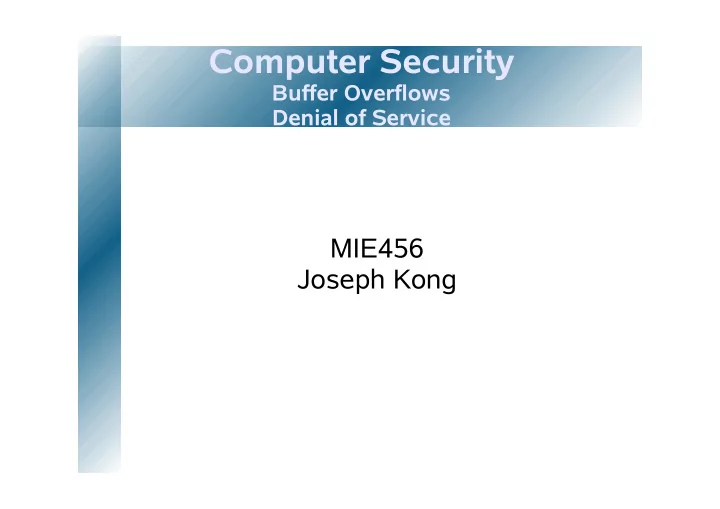

Computer Security Buffer Overflows Denial of Service MIE456 Joseph Kong
Overview Program Exploitation Buffer Overflows Memory Declaration Smashing The Stack TCP/IP Three Way Handshake Denial of Service SYN Flooding Smurf Attacks System Overloads Summary
Program Exploitation Definition: Exploiting a program is simply a clever way of getting the computer to do what you want it to do, even if the currently running program was designed to prevent that action Programs follow the letter of the law
Buffer Overflows Memory Declaration Null Byte Termination Program Memory Segmentation text data bss heap stack
Buffer Overflows Memory Declaration Cont. Extended Instruction Pointer (EIP) Program Flow 1.Read the instruction that EIP is pointing to 2.Add the byte-length of the instruction to EIP 3.Execute the instruction that was read in step 1 4.Go to step 1
Buffer Overflows Memory Declaration Cont. void test(int a, int b, int c, int d){ The top of the stack char flag; buffer Low addresses flag char buffer; } return address a void main(){ b test(1, 2, 3, 4) c } d High addresses
Buffer Overflows Smashing The Stack overflow.c code void overflow (char *str){ buffer char buffer [20]; //function that copies str to buffer strcpy(buffer, str); } return address int main(){ char big_string[128]; int i; for(i=0; i < 128; i++){ overflow.c results //fill big_string with 'A's big_string[i] = 'A'; } $ gcc -o overflow overflow.c $ ./overflow overflow(big_string); Segmentation fault exit(0); $ }
TCP/IP Three Way Handshake 1. initial SYN sent client server 2. ACK sent with reply SYN 3. final ACK sent client server
Denial of Service SYN Flooding SYN Attack Using A Spoofed Return Address spoofed SYN packet IP Addr: 192.168.0.5 hacker server IP Address: 192.168.0.1 Reply SYN ACK Packet Sent To Spoofed Addr: 192.168.0.5 random computer IP Address: 192.168.0.5
Denial of Service Smurf Attacks Broadcast Address One address that every computer will answer to Used to update name lists and other necessary items that computers need to keep the network up and running Broadcast Storm send a request to a network using the broadcast address with the return address of the broadcast address
Denial of Service System Overloads DOS attack directed against the software running on the target computer Average 5-50 bugs/thousand lines of code If an attacker knows how to exploit a specific bug, she can shut down the target computer
Summary Hacking is really just the act of finding a clever and counterintuitive solution to a problem A buffer overflow attack is exactly what its name implies A DOS simply prevents access to a service or resource
References 1. Erickson, Jon. (2003) Hacking: The Art Of Exploitation. San Francisco: No Starch Press 2. Hoglund, Greg, and Gary McGraw. (2004) Exploiting Software: How To Break Code. Boston: Addison Wesley 3. Peikari, Cyrus and Seth Fogie. (2003) Maximum Wireless Security. Indiana: Sams
Recommend
More recommend